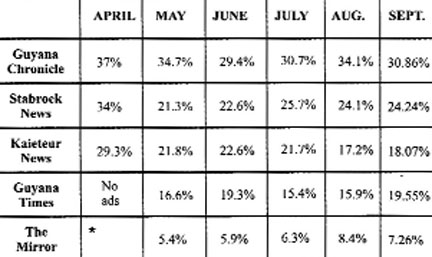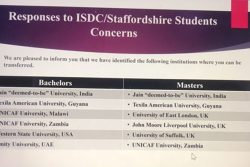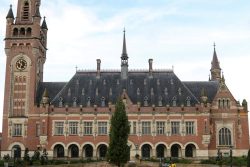Just under two years since its launch, the Guyana Times secured its highest tranche of state advertising yet – 22% for the month of April, 2010
It was on par with the Stabroek News and five per cent above the previous government favourite – Kaieteur News (KN). The state-owned Guyana Chronicle maintained the number one spot with 29.84% and throughout the period assessed it has commanded figures as high as 34% though its circulation is low.
Last month, KN in a notice to readers announced that it was increasing the cover price for its daily and Sunday editions by $20 to cover the loss of advertising revenue due to the diminished flow of state advertising. Stabroek News which had had all of its state ads pulled for 17 months in 2007 did not raise its prices during this period.
How state advertising is distributed became a major issue in 2007 when the Government Information Agency (GINA) suddenly withdrew state ads from SN that year without explanation. When SN went public with the cut-off, government officials and GINA then argued that it was the policy that the state paper would receive ads along with the privately-owned newspaper with the highest circulation. It then identified this newspaper to be KN without the benefit of any analysis of circulation or sectoral preference.
Despite widespread local and international condemnation of its abuse of press freedom, the government kept the ban in place for 17 months until April 2008 when it resumed advertising without an explanation. The launching of the Guyana Times a few months later by one of President Bharrat Jagdeo’s friends was thought to be the reason behind the resumption of advertising with SN. It was believed that the government wanted to advertise with the Times but would find it hard to explain since it had ceased advertising with SN. This postulate was given even greater credence when less than a year after its launch the Times began receiving ads from GINA. Again, there was no explanation for this and Stabroek News’ attempts to elicit an official explanation from the government on the move failed.
Stabroek News had previously charted the distribution of ads from April to September 2009. (See chart lower down in story)
Ad distribution for October 2009 to April 2010
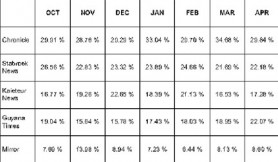 For the period October 2009 to April 2010, the Guyana Chronicle held the number one spot throughout – its share ranging from 28.76% to 34.68%. Stabroek News occupied the second position throughout with a tally that ranged between 21.69% and 26.56%. The KN allotment varied from 16.53% to 22.65% and third place went back and forth between it and the Guyana Times.
For the period October 2009 to April 2010, the Guyana Chronicle held the number one spot throughout – its share ranging from 28.76% to 34.68%. Stabroek News occupied the second position throughout with a tally that ranged between 21.69% and 26.56%. The KN allotment varied from 16.53% to 22.65% and third place went back and forth between it and the Guyana Times.
Following the publication of a SN news item in October last year highlighting that the Guyana Times had already notched 19% of the state ads for the month of September there was a gradual pullback of ads from it by GINA. So while the Times was ahead of KN in October 2009, it fell behind for November, December, January and February. The Times ad quota however surged ahead of KN for the months of March and April. The Times registered between 15.64% and 22.07% of state ads.
The weekly Mirror newspaper – closely aligned to the PPP/C government secured allotments varying from 6.44% to 13.98%.
Distribution of GINA ads from April 2009 to September 2009
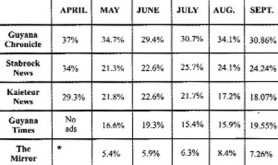 In a comment, Stabroek News Editor-in-Chief (EiC) Anand Persaud said that the distribution pattern solidifies the widely held view that government institutes important policies in a capricious manner and to favour its friends.
In a comment, Stabroek News Editor-in-Chief (EiC) Anand Persaud said that the distribution pattern solidifies the widely held view that government institutes important policies in a capricious manner and to favour its friends.
Persaud pointed out that in a statement issued on January 15, 2007, GINA said “The basis for the placement of advertisements in the media is linked to the public’s response to such advertisements. Huge responses to our advertisements emanate from the Kaieteur News and Guyana Chronicle. And we are constantly seeking to maximize the impact of its advertisements, in the interest of efficiency… Kaieteur News today is the largest private newspaper in this country and therefore attracts a disproportionately greater number of government’s advertisements. An added advantage with releasing numerous advertisements to Kaieteur News has to do with its wider dissemination not only nationally but also internationally within the Guyanese Diaspora in New York City”.
President Bharrat Jagdeo had said much the same on January 26, 2007 when he told reporters that the axing of GINA ads to SN was purely a business decision and that the government would advertise in two dailies – the state-owned Guyana Chronicle and the privately-owned KN and some newspapers published at the weekend – a reference to the Mirror newspaper.
In October 2007, the President had also said “Suddenly, because there is this shift, they [SN] are now making it a press freedom issue. It is not a press freedom issue because we have not stopped spending the government’s revenue in advertising in the private sector or private newspapers. We have just made a switch to the larger circulating newspaper [KN] because we get more value for money. We reach more homes with the same amount of money, investing in advertising in that particular newspaper,” the President said. He added that if Stabroek News wants to change this the newspaper needs to get its circulation rate up again.
Persaud said the statements by the various government officials have been completely refuted by the current allocations. Not only was government now regularly advertising in three private daily newspapers but its previous favourite KN is now regularly relegated to the third spot. Government sources have since sought to justify the allocations by saying that the government had returned to the distribution policy in place prior to the withdrawal of ads from Stabroek News in 2007.
Persaud said that political decisions have clearly come into play in the ads ratio and this is exactly what SN had fought strenuously against for 17 months. Persaud noted that just months before his passing SN’s Editor-in-Chief, David de Caires had argued persuasively that the apportioning of ads should be done on a professional basis and taken out of the hands of the politicians at the Office of the President.
He had argued that the distribution of state ads should be assigned to a professional advertising agency which would be aware of not only the paid circulation of the various newspapers but also the segments of the market that they reach. For instance, SN has been widely recognized as being the most read journal in the business community. These factors should then determine the sharing of ads. De Caires had proposed that an Audit Bureau of Circulation team from the Caribbean be deputed to conduct an analysis of circulation patterns. Persaud noted that these very reasonable proposals by de Caires were completely ignored by President Jagdeo.
Persaud said the acrobatics over the apportioning of ads should be of great interest to donors and others who are concerned with good governance and accountability for taxpayers’ dollars. The developments he said also constituted a continuous breach of the hemispheric press freedom Declaration of Chapultepec which says at principle 7 “Tariff and exchange policies, licences for the importation of paper or news-gathering equipment, the assigning of radio and television frequencies and the granting or withdrawal of government advertising may not be used to reward or punish the media or individual journalists.”
The EiC said the new developments were also a salutary lesson about solidarity on press freedom issues. Persaud recalled that when Stabroek News’ ads were cut off, the Kaieteur News sided with the government and harvested the increased amount of advertising that was then available to it. In October 2007 when SN mounted an historic protest against the government over the ads issue, the KN hierarchy instructed its staff not to offer solidarity to this newspaper. Persaud said that KN allied itself to the government without realizing that it too could eventually become a target as it was now contending.
